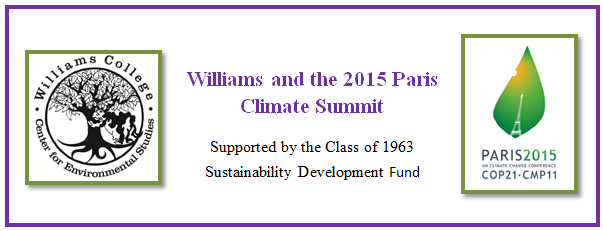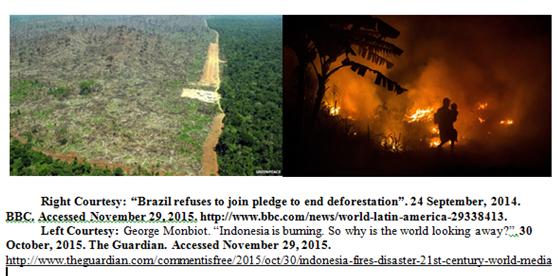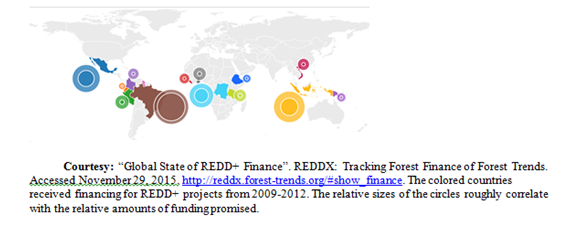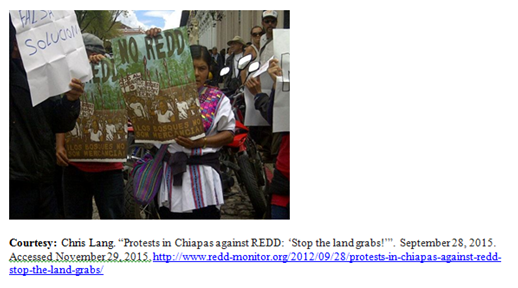By Daniel Wong, Physics major, Class of 2017
When we think of anthropogenic global warming, we conjure up billowing plumes of smoke from coal-fired energy plants or cars idling in miles of traffic. While the burning of fossil fuels accounts for a majority of humanity’s CO2 emissions, second is land use change, specifically deforestation and forest degradation (Le Quéré et al. 2014). For some countries, like Indonesia and Brazil (two tremendous carbon emitters), deforestation and forest degradation constitute a majority of their carbon footprints. Fossil fuel emissions are highly visible to the urbanized populations of (post)industrial nations—that is, to the world’s most powerful and civically empowered. Forests, on the other hand, are comparatively obscured in the global public conception of climate change and its causes. Even more obscured are the locals and indigenous populations that care for the world’s forests and the governmental, economic, and natural challenges they face. As evidence, look no further than a recent article in the Guardian: “Indonesia is burning. So why is the world looking away?”
Despite minimal public recognition of the problem, the international diplomatic community has taken considerable initiative and interest in forests and deforestation with respect to climate change. The UNFCCC has adopted a fully articulated (but yet to be fully implemented) international mitigation mechanism known as REDD+, pronounced “red-plus” and standing for Reducing Emissions from Deforestation and forest Degradation. The “plus” refers to incentivizing positive steps beyond slowing or preventing the “negatives” of deforestation and forest degradation; it consists of active stewardship, sustainable management, and enhancement of forest carbon stocks (Costenbader et al. 2015). There have been hundreds of REDD pilot projects, mostly aimed at capacity building, through bilateral agreements and multilateral funds in the past decade (Norman and Nakhooda 2014). However, a truly international and robust financing mechanism awaits deliberation in Paris (Zwick 2015). A worryingly sparse draft of the negotiating text for Paris released on October 5 contained only a single reference to forests, and not a single mention of REDD+. However, the most recent draft released on October 23, much thicker and denser than the previous, is replete with discussion of land use and heralds REDD+ as an “immediately implementable, scalable, and results-based” mitigation mechanism. So, the Conference of the Parties in Paris this December, or COP21, will certainly be debating REDD+ and its implementation. Below are a brief description of REDD+ and two of its glaring inconsistencies, one of which constitutes the biggest issue regarding REDD+ implementation, and the other a possible explanation as to why REDD+ has disappeared and reappeared in draft texts leading up to Paris.
REDD+: The Science and the Mechanism
Because of photosynthesis, a tree will absorb more CO2 than it releases in its lifetime. Forests, in turn, are considered carbon “sinks,” environments that sequester more CO2 than they release. However, combusted or decomposing trees due to deforestation and forest degradation release this sequestered carbon and halt future carbon sequestration. So, REDD+ projects seek to assign more “value” to a living tree than a felled one, thus incentivizing their preservation over deforestation. “Value” can generally be taken as economic: a developed country provides funding to a forested nation, conditional on the forested nation’s prevention of deforestation or forest degradation (against business as usual projections). In turn, the developed country counts this carbon sequestration towards its mitigation efforts. However, this has frequently put local and indigenous communities at odds with overreaching governments (Phelps et al. 2010). Accordingly, negotiators in Bonn this June adopted, with much excitement and fanfare, the final formulations of REDD+: “safeguards” against unintended consequences of REDD+ projects as well as provisions for the “non-carbon benefits” of REDD+ (Silva-Chávez June 2015; Zwick). Specifically, the safeguards address concerns of emissions displacement as opposed to reduction (also known as leakage), perverse incentives arising from marketization of forest stocks, and overlooked and jeopardized local and indigenous populations (“Clarifying Non-Carbon Benefits” 2014). For more detailed histories, analyses, and coverage, visit REDDesk and Code REDD or REDDMonitor for, respectively, positive and negative discussions of REDD+.
Issue of Implementation: Governance
Ten years of pilot projects, critiques, and revisions to REDD+ have revealed a disconcerting inconsistency that must to be dealt with in the Paris negotiations. Though it describes non-carbon benefits as, among other things, the protection of and participation by local and indigenous populations in forest preservation, REDD+ only directly engages with and finances state actors, indirectly encouraging centralized forest management (Phelps et al.). We can understand, to some degree, its exclusive engagement with states by considering its origin. In 2005, the Coalition of Rainforest Nations, led by Papua New Guinea but with Brazil a notable absentee, first put forth for discussion deforestation as a significant carbon emissions source. The Convention, motivated by a single influential policy review, quickly took up forest carbon sinks as a cheap emission mitigation option in 2007, and REDD+ was born (Schroeder 2015). The “safeguards” and “non-carbon benefits”, which ostensibly better protect and enable subnational forest stakeholders, were not articulated until several years later and not adopted into REDD+ until June, 2015. In other words, it should not be surprising that REDD+ funnels exclusively through states. The mitigation mechanism is not the outcome of civic, grassroots efforts by local or indigenous communities of the world’s forests. So, the central issue for REDD+ is the determination of the proper and recognized levels of governance, but state delegates at the main negotiations are unlikely to be the ones to arrive at such a resolution (Kamleshan and Ramsay 2015). Within COP21, official side-events are more likely arenas for serious, nuanced debate and resolution of the governance question.
What explains REDD+’s absence and presence in consequent negotiation texts?
Another inconsistency the Paris negotiators must face with REDD+ is its language and logic. The Kyoto Protocol, the last legally binding regime entered into force under the UNFCCC, based its implementation on the UNFCCC’s notion of historical carbon emitters, the most developed countries of the 1990s as well as some Central and Eastern European states, and historical non-emitters, or everyone else. Under the Protocol, only historical contributors were required to curb their emissions. Financing for REDD+, following in Kyoto’s footsteps, is supposed to come from developed nations (the historical emitters) and be funneled to developing nations (the historical non-emitters) to permit sustainable development. International environmental diplomacy, specifically on behalf of developed nations, has sought to move away from this developed/developing binary for reasons about which this blog post will not go into detail (see blog posts X, Y). In short, the binary is outdated (considering that China, for instance, has been the largest emitter in the world since 2007 but is considered a historical non-emitter) and counteracts the INDC-basis for COP21. The explicit developed/developing binary may have partly motivated the absence of REDD+ in the October 5 draft and was certainly reflected in its reintroduction in the October 23 draft by developing states, specifically the Coalition for Rainforest Nations (Silva-Chávez October 2015).
Heading into the negotiations of COP21, half a year removed from the anticipation generated after its final philosophical formulations were adopted in Bonn in June, REDD+ is clearly not a fully consistent mechanism. And while smaller nations in the Coalition for Rainforest Nations will be referencing it directly, the INDC of Brazil (the significant nonparty to the Coalition and site of many REDD projects) hardly references REDD+ and reserves that no foreign nation may credit itself with carbon offsetting through a REDD+ project in Brazilian territory, which might diminish interest of developed countries in deliberating over financing the mechanism in the main negotiations if their mitigation targets cannot benefit from carbon offsetting through REDD+. At the main negotiations, expect small, developing forested nations with unfortunately limited diplomatic clout to spearhead any REDD+ discussion. I have not discussed a host of other specific debates—along technical, economic, and human rights dimensions—surrounding the necessity and efficacy of REDD+, most of which will be discussed in official side events and will significantly impact its implementation on the ground. Further, it is worth acknowledging how contentious REDD+ is among policy analysts, human rights advocates, and local and indigenous peoples themselves—there will certainly be debate about it outside of official negotiating halls, whether in the news or in the streets. If REDD+ has piqued your interest, you will find most of its interesting and pertinent questions discussed outside the main plenary of COP21.
Acknowledgments:
Many thanks to Professor Pia Kohler, Claire Swingle, and Annie Tewksbury for revisions of this blog post. Thanks also to Jen Allan of UBC for sharing her expertise on REDD+ and its prospects for COP21.
Bio:
Daniel Wong ‘17 is from San Francisco, CA. A physics major, he holds the newfound belief that the only things harder to specify than the position and momentum of a quantum mechanical particle are the necessary compromises of a successful multilateral environmental agreement.
Bibliography:
ADP 2-11, of the UNFCCC. 2015. “Draft agreement and draft decision on workstreams 1 and 2 of the Ad Hoc Working Group on the Durban Platform for Enhanced Action”, Released October 23, 2015.
Costenbader, John, Luke Pritchard, Hilda Galt, Stephanie Roe, and Lauren Stanley. NAMAs and REDD+. Relationship and main issues for consideration – with a focus on Southeast Asia. First draft for consultation. GIZ, Eschborn, Germany. Available from http://mitigationpartnership.net/sites/default/files/giz-namasandredd-web-20131031.pdf. 2013.
“Clarifying the Role of Non-Carbon Benefits in REDD.” UNFCCC, 23 Feb. 2014. Accessed 19 Oct. 2015. http://unfccc.int/resource/docs/2014/smsn/ngo/405.pdf
Federative Republic of Brazil. 2015. “Intended Nationally Determined Contribution”, Submitted September 28, 2015.
Holloway, Vivienne, and Esteban Giandomenico. “The History of REDD Policy”. Carbon Planet White Paper, Adelaide, Australia (2009).
Co-Chairs of the ADP the UNFCCC. 2015. “Non-paper: Note by the Co-Chairs”, Released October 5, 2015.
Phelps, Jacob, Edward Webb, and Arun Agrawal. “Does REDD Threaten to Recentralize Forest Governance?” Rights and Resources. April 16, 2010. Accessed October 13, 2015. http://www.rightsandresources.org/documents/files/doc_1461.pdf.
Schroeder, Heike. “REDD.” In Essential Concepts of Global Environmental Governance, 167-168. New York: Routledge, 2015.
Silva-Chávez, Gustavo. “Bonn Climate Talks Make Progress, REDD Is the Big Winner in June 2015” Forest Trends. June 11, 2015. Accessed October 13, 2015. http://forest-trends.org/blog/2015/06/11/bonn-climate-talks-make-progress-redd-is-the-big-winner-in-june-2015/
Silva-Chávez, Gustavo. “The Return of REDD+ Signals Good News from Bonn” Forest Trends. October 20, 2015. Accessed November 29, 2015. http://forest-trends.org/blog/2015/10/20/the-return-of-redd/
Le Quéré, Corinne, R. Moriarty, R. M. Andrew, G. P. Peters, Philippe Ciais, Pierre Friedlingstein, S. D. Jones et al. “Global carbon budget 2014.” Earth System Science Data Discussions 7, no. 2 (2014): 521-610.
Norman, Marigold, and Smita Nakhooda. “The State of REDD+ finance.” CGD Climate and Forest Paper series 5 (2014).
Zwick, Steve. “Climate Negotiators Deliver Win for Forests with Breakthrough in Bonn” Ecosystem Marketplace. June 9, 2015. Accessed November 16, 2015. http://www.ecosystemmarketplace.com/articles/climate-negotiators-deliver-win-for-forests-with-breakthrough-in-bonn/



